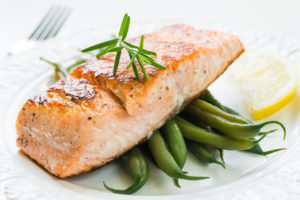
 February is American Heart Month. When it comes to eating a heart healthy diet, controlling portion size, increasing servings of fruits and vegetables, and choosing more whole grains are so important. Here, Mayo Clinic offers 8 steps to get started in the right direction.
February is American Heart Month. When it comes to eating a heart healthy diet, controlling portion size, increasing servings of fruits and vegetables, and choosing more whole grains are so important. Here, Mayo Clinic offers 8 steps to get started in the right direction.
Although you might know that eating certain foods can increase your heart disease risk, it’s often tough to change your eating habits. Whether you have years of unhealthy eating under your belt or you simply want to fine-tune your diet, here are eight heart-healthy diet tips. Once you know which foods to eat more of and which foods to limit, you’ll be on your way toward a heart-healthy diet.
1. Control your portion size. How much you eat is just as important as what you eat. Overloading your plate, taking seconds and eating until you feel stuffed can lead to eating more calories than you should. Portions served in restaurants are often more than anyone needs.
Use a small plate or bowl to help control your portions. Eat larger portions of low-calorie, nutrient-rich foods, such as fruits and vegetables, and smaller portions of high-calorie, high-sodium foods, such as refined, processed or fast foods. This strategy can shape up your diet as well as your heart and waistline.
Keep track of the number of servings you eat. The recommended number of servings per food group may vary depending on the specific diet or guidelines you’re following. A serving size is a specific amount of food, defined by common measurements such as cups, ounces or pieces. For example, one serving of pasta is about 1/3 to 1/2 cup, or about the size of a hockey puck. A serving of meat, fish or chicken is about 2 to 3 ounces, or about the size and thickness of a deck of cards. Judging serving size is a learned skill. You may need to use measuring cups and spoons or a scale until you’re comfortable with your judgment.
2. Eat more vegetables and fruits. Vegetables and fruits are good sources of vitamins and minerals. Vegetables and fruits are also low in calories and rich in dietary fiber. Vegetables and fruits, like other plants or plant-based foods, contain substances that may help prevent cardiovascular disease. Eating more fruits and vegetables may help you cut back on higher calorie foods, such as meat, cheese and snack foods.
Featuring vegetables and fruits in your diet can be easy. Keep vegetables washed and cut in your refrigerator for quick snacks. Keep fruit in a bowl in your kitchen so that you’ll remember to eat it. Choose recipes that have vegetables or fruits as the main ingredients, such as vegetable stir-fry or fresh fruit mixed into salads.
Fruits and vegetables to choose:
- Fresh or frozen vegetables and fruits
- Low-sodium canned vegetables
- Canned fruit packed in juice or water
Fruits and vegetables to limit:
- Coconut
- Vegetables with creamy sauces
- Fried or breaded vegetables
- Canned fruit packed in heavy syrup
- Frozen fruit with sugar added
3. Select whole grains. Whole grains are good sources of fiber and other nutrients that play a role in regulating blood pressure and heart health. You can increase the amount of whole grains in a heart-healthy diet by making simple substitutions for refined grain products. Or be adventuresome and try a new whole grain, such as whole-grain farro, quinoa or barley.
Grain products to choose:
- Whole-wheat flour
- Whole-grain bread, preferably 100% whole-wheat bread or 100% whole-grain bread
- High-fiber cereal with 5 g or more fiber in a serving
- Whole grains such as brown rice, barley and buckwheat (kasha)
- Whole-grain pasta
- Oatmeal (steel-cut or regular)
Grain products to limit or avoid:
- White, refined flour
- White bread
- Muffins
- Frozen waffles
- Corn bread
- Doughnuts
- Biscuits
- Quick breads
- Cakes
- Pies
- Egg noodles
- Buttered popcorn
- High-fat snack crackers
4. Limit unhealthy fats. Limiting how much saturated and trans fats you eat is an important step to reduce your blood cholesterol and lower your risk of coronary artery disease. A high blood cholesterol level can lead to a buildup of plaques in your arteries, called atherosclerosis, which can increase your risk of heart attack and stroke.
The American Heart Association offers these guidelines for how much fat to include in a heart-healthy diet:
- Saturated fat: No more than 5 to 6% of your total daily calories, or no more than 11 to 13g of saturated fat if you follow a 2,000-calorie-a-day diet
- Trans fat: Avoid
You can reduce the amount of saturated fat in your diet by trimming fat off your meat or choosing lean meats with less than 10 percent fat. You can also add less butter, margarine and shortening when cooking and serving.
You can also use low-fat substitutions when possible for a heart-healthy diet. For example, top your baked potato with low-sodium salsa or low-fat yogurt rather than butter, or use sliced whole fruit or low-sugar fruit spread on your toast instead of margarine.
You may also want to check the food labels of some cookies, cakes, frostings, crackers and chips. Some of these — even those labeled “reduced fat” — may be made with oils containing trans fats. One clue that a food has some trans fat in it is the phrase “partially hydrogenated” in the ingredient list.
When you do use fats, choose monounsaturated fats, such as olive oil or canola oil. Polyunsaturated fats, found in certain fish, avocados, nuts and seeds, also are good choices for a heart-healthy diet. When used in place of saturated fat, monounsaturated and polyunsaturated fats may help lower your total blood cholesterol. But moderation is essential. All types of fat are high in calories.
An easy way to add healthy fat (and fiber) to your diet is ground flaxseed. Flaxseeds are small brown seeds that are high in fiber and omega-3 fatty acids. Some studies have found that flaxseeds may help lower cholesterol in some people, but more research is needed. You can grind the seeds in a coffee grinder or food processor and stir a teaspoon of them into yogurt, applesauce or hot cereal.
Fats to choose:
- Olive oil
- Canola oil
- Vegetable and nut oils
- Margarine, trans fat free
- Cholesterol-lowering margarine, such as Benecol, Promise Activ or Smart Balance
- Nuts, seeds
- Avocados
Fats to limit:
- Butter
- Lard
- Bacon fat
- Gravy
- Cream sauce
- Nondairy creamers
- Hydrogenated margarine and shortening
- Cocoa butter, found in chocolate
- Coconut, palm, cottonseed and palm-kernel oils
5. Choose low-fat protein sources. Lean meat, poultry and fish, low-fat dairy products, and eggs are some of your best sources of protein. But be careful to choose lower fat options, such as skim milk rather than whole milk and skinless chicken breasts rather than fried chicken patties.
Fish is another good alternative to high-fat meats. And certain types of fish are rich in omega-3 fatty acids, which can lower blood fats called triglycerides. You’ll find the highest amounts of omega-3 fatty acids in cold-water fish, such as salmon, mackerel and herring. Other sources are flaxseed, walnuts, soybeans and canola oil.
Legumes — beans, peas and lentils — also are good sources of protein and contain less fat and no cholesterol, making them good substitutes for meat. Substituting plant protein for animal protein — for example, a soy or bean burger for a hamburger — will reduce your fat and cholesterol intake and increase your fiber intake.






